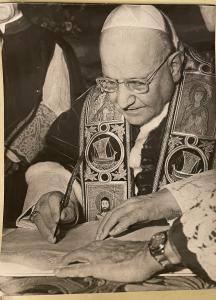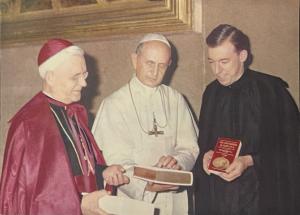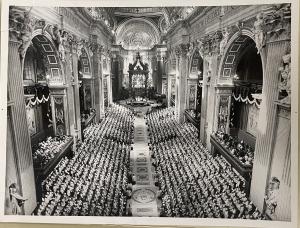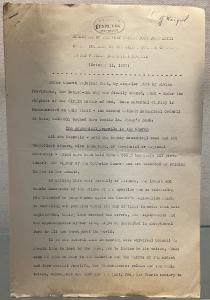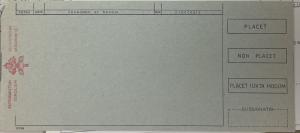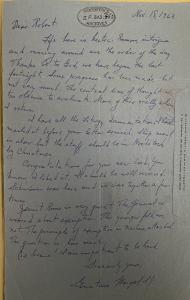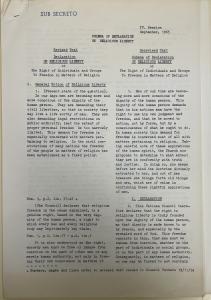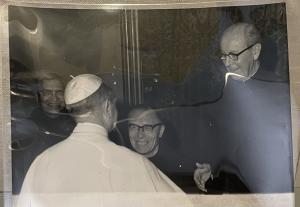The meeting of the 21st ecumenical council of the Catholic Church, otherwise known as Vatican II, was one of the most pivotal events of the 20th century. Commenced by Pope John XXIII, and lasting 4 sessions (1962-1965), the council was the largest gathering of the leadership of the catholic church in history, with over 2000 bishops from all over the world in attendance.
By the time of the council, the Catholic Church had long been in an oppositional stance to modernity, and it found itself increasingly defensive, insular, and centered around papal authority. However, the 20th century saw the slow emergence of counter theological movements (eg. Nouvelle théologie, Ressourcement), that would finally allow for a renewal of the church at Vatican II in a way that was neither an abandonment of tradition, nor retrenchment, but an updating, or aggiornamento, as John XXIII called it.
Over the course of four years, bishops met to discuss, refine, and vote upon 16 documents, drafted and revised by specially tasked commissions of theologians and experts, touching on nearly every aspect of church life. In a marked change of attitude, outside observers from Protestant and Eastern Orthodox churches were also invited to observe, no longer being referred to as heretics and schismatics, but separated brethren.
The 16 documents promulgated were to have immense influence both internally and externally. Churches were now allowed to celebrate Mass in the vernacular (Sacrosanctum Concilium), the state protection of religious liberty was affirmed (Dignitatis Humanae), and ecumenical and inter-religious dialog was opened (Nostra Aetate, Lumen Gentium), among many other changes. Sixty years later, the meaning of Vatican II continues to be debated, but its influence, whether judged positively or negatively, can not be denied.
Photograph of Pope John XXIII signing the call for the opening of the Second Vatican Council, 1962
Anna M. Brady Papers, Box 24, Folder 35
Booth Family Center for Special Collections
Pope John Paul XXIII caught the church completely by surprise in 1959 when he announced his decision to call a new ecumenical council together.
Photograph of Pope Paul VI (Center)
Anna M. Brady Papers, Box 24, Folder 58
Booth Family Center for Special Collections
With the death of Pope John XXIII, Giovanni Montini was elected Pope Paul VI and was instrumental in continuing the work of the council, reconvening it in 1963 and bringing it to a close in 1965.
Letter to Gustave Weigel, S.J., from Cardinal Augustin Bea, Oct 25th, 1960
Gustave Weigel, S.J. Papers, Box 1, Folder 6
Booth Family Center for Special Collections
Cardinal Augustin Bea, one of the most influential figures in Vatican II, was head of the Secretariat for Promoting Christian Unity (SPCU), a preparatory commission of the council. In this letter, Bea invites Gustave Weigel, S.J., a noted Jesuit ecumenist and theologian to serve as an advisor. Commissions such as the SPCU, drafted schema for the council to consider and vote upon.
Photograph of the Council in Session
Anna M. Brady Papers, Box 24, Folder 71
Booth Family Center for Special Collections
During the council, Bishops gathered almost daily to debate the drafts in St. Peter’s Basilica, the only site capable of hosting such a large gathering. These debates were held exclusively in Latin.
Opening Ceremony Program, Oct 11, 1962
Gustave Weigel, S.J. Papers, Box 9, Folder 378
Booth Family Center for Special Collections
Discourse of the Holy Father Pope John XXIII on the Opening of Vatican II, Oct 11, 1962
Gustave Weigel, S.J. Papers, Box 9, Folder 378
Booth Family Center for Special Collections
Schemata Constitutionum et Decretorum ex quibus argumenta in concilio disceptanda seligentur, 1962
Gustave Weigel, S.J. Papers, Box 9, Folder 378
Booth Family Center for Special Collections
Drafts of the constitutions and decrees, from which the topics to be debated in the council are selected.
Council Ballot
Gustave Weigel, S.J. Papers, Box 9, Folder 380
Booth Family Center for Special Collections
Ballots, such as the one displayed, were used by attending Bishops to vote on the acceptance or rejection of the documents promulgated by the council.
Norms for Work During the Interval between the First and Second Session of the Council
John F. Long, S.J. Archives, Box 6, Folder 8
Booth Family Center for Special Collections
Despite the hope that Vatican II would wrap up in a matter of a few months, it took four years and four sessions to complete its work. The document makes clear that although the first session was closed in December, work would continue on the documents until the second session reconvened the following September.
Gustave Weigel, S.J. Correspondence Concerning the Second Session, Nov 18, 1963
Gustave Weigel, S.J. Papers, Box 1, Folder 67
Booth Family Center for Special Collections
In his correspondence, Gustave Weigel, S.J., writes to friends noting the hectic pace of the day-to-day work of the council. Weigel served as an interpreter for the press and outside observers.
Text and Revisions of the Declaration on Religious Liberty (Dignitatis Humanae), Sep, 1965
John F. Long, S.J. Archives, Box 6, Folder 14
Booth Family Center for Special Collections
One of the most important documents to be promulgated by Vatican II, Dignitatis Humanae declared the church’s support for the protection of religious liberty. The text displayed shows how the document underwent multiple revisions over the course of the council. The American Jesuit, John Courtney Murray, was a key voice in drafting the text.
Curated by Adrian Vaagenes with thanks to Stephanie Hughes

